Abstract
This paper reviews the literature on the incidence and duration of breast-feeding in various countries, the volume and composition of breast milk, the health and nutrition of breast-fed babies as judged by growth and morbidity, maternal nutritional requirements during lactation, and the effect of prolonged lactation on maternal health. It appears that lactation can be as well sustained by impoverished as by affluent mothers, and that even in communities where malnutrition is common the average growth of infants is satisfactory up to the age of about 3 months on a diet of breast milk alone. Breast milk appears to have specific anti-infective properties, but prolonged breast-feeding will not prevent infections among older infants reared in a poor environment. The authors believe that breast-feeding is the best form of nutrition for the young infant and deplore its decline in modern industrial societies. The recommendations of various FAO/WHO Expert Groups on nutritional intakes during lactation are summarized. The need for an increased daily energy intake of 4.2 MJ (1 000 kcal) is questioned, and an increase of 2.5 MJ (600 kcal) is suggested. Data on the effect of prolonged lactation on the health of the mother are scanty; body weight appears to be maintained even among poorly nourished mothers. The authors stress the need for well-planned and technically adequate studies of the material and psychological factors involved in breast feeding.
Full text
PDF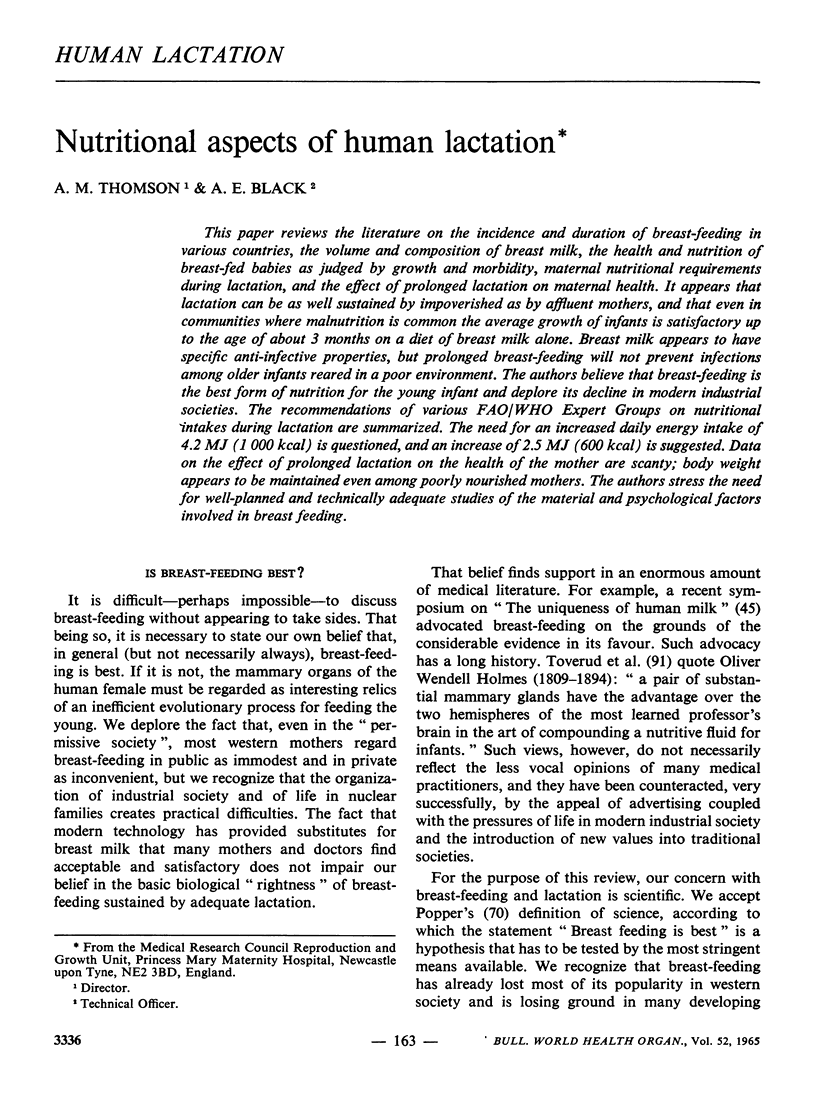



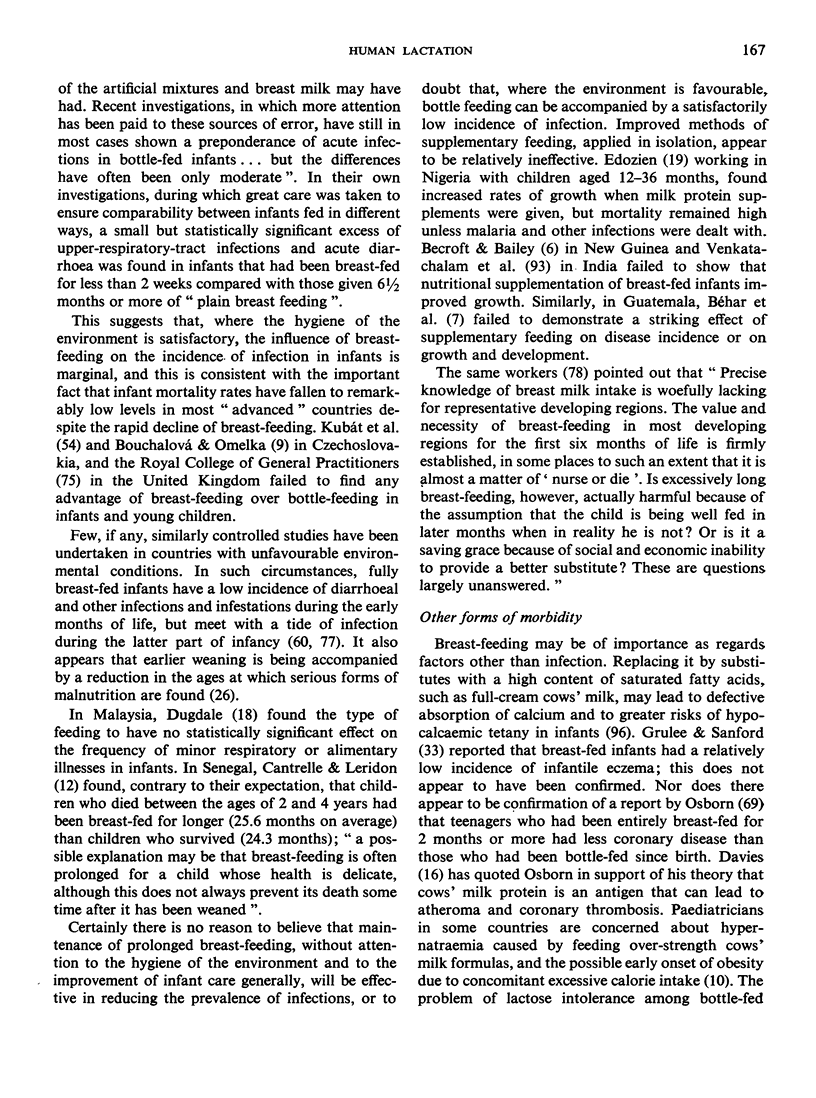

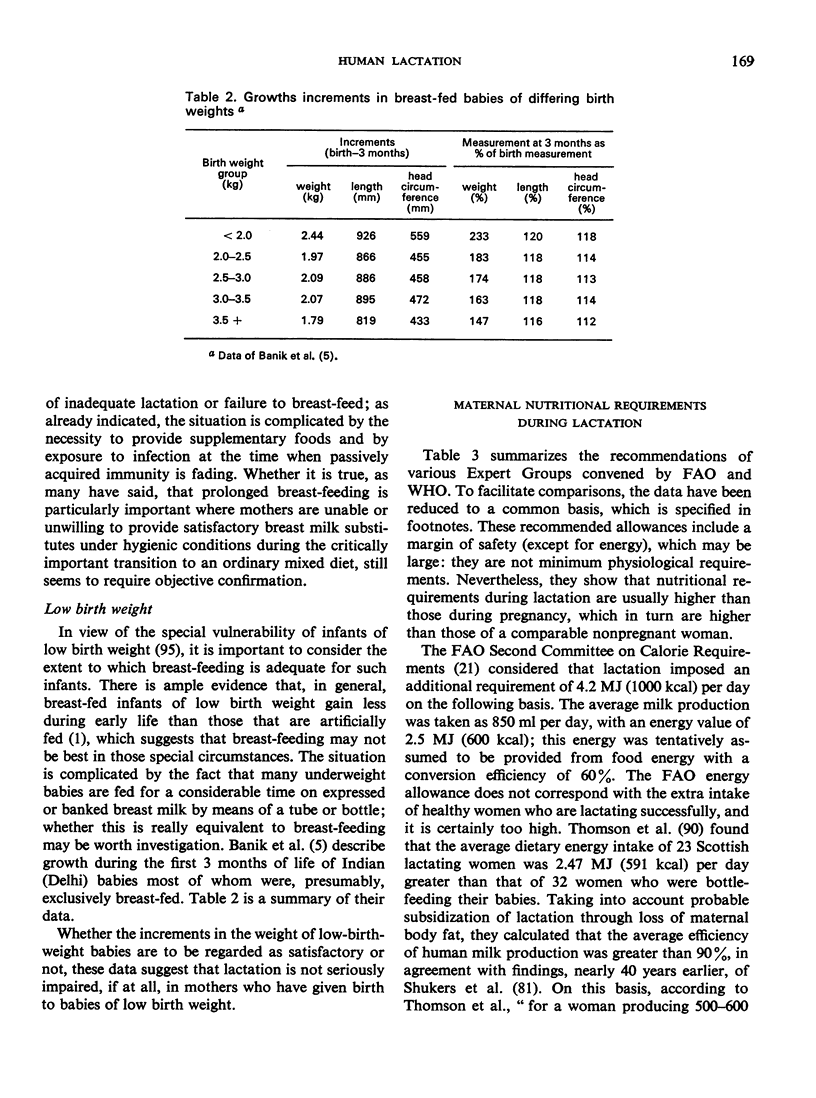




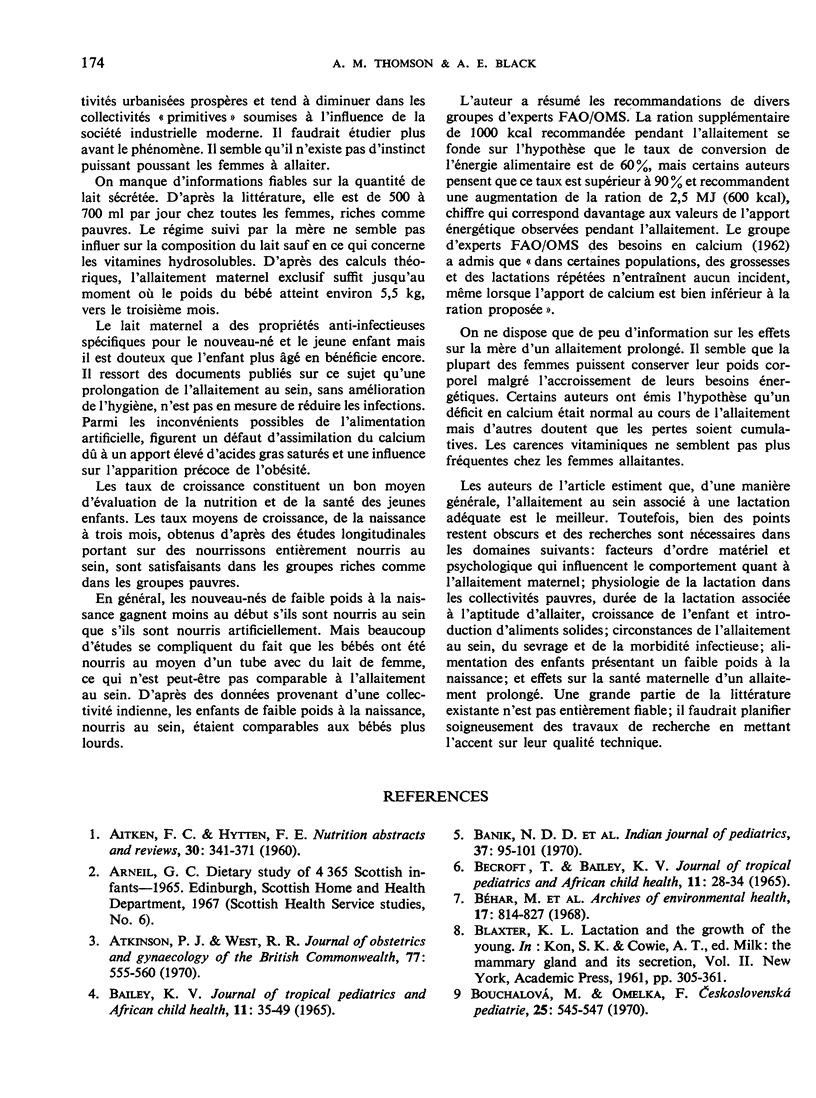

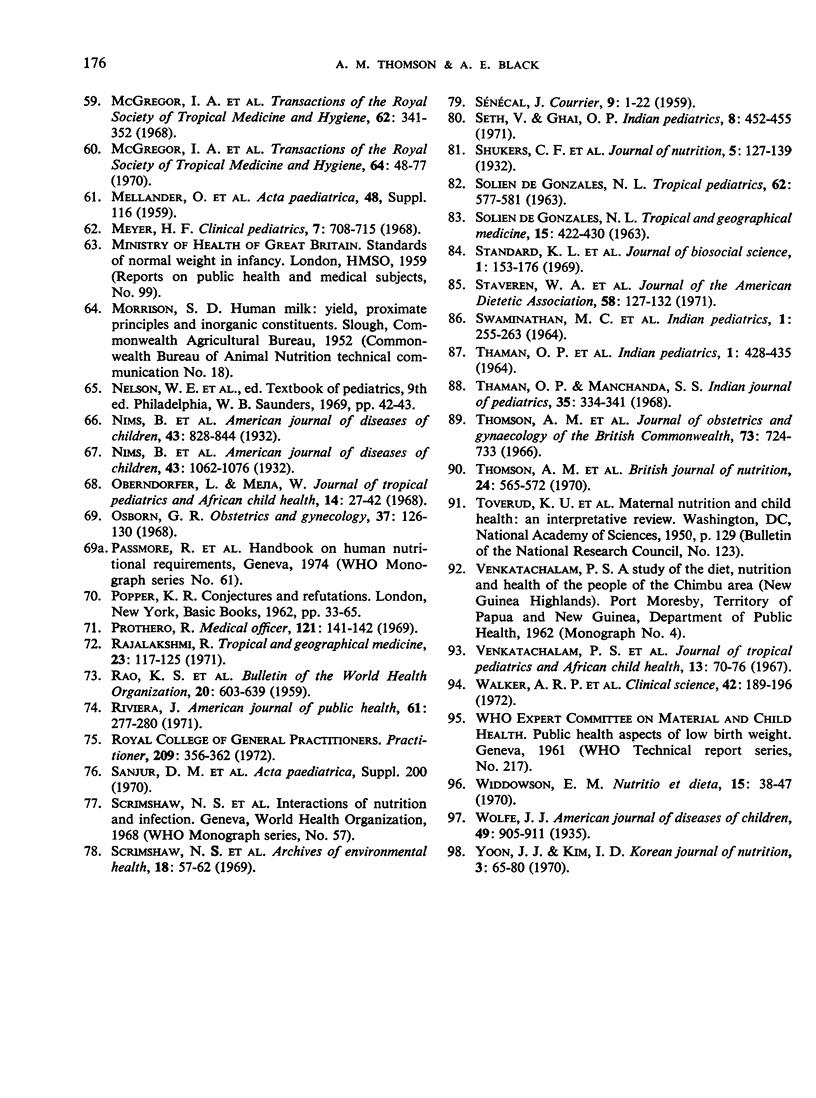

Selected References
These references are in PubMed. This may not be the complete list of references from this article.
- AITKEN F. C., HYTTEN F. E. Infant feeding: comparison of breast and artificial feeding. Nutr Abstr Rev. 1960 Apr;30:341–371. [PubMed] [Google Scholar]
- Banik N. D., Krishna R., Mane S. I., Raj L. A longitudinal study on physical growth of children of different birth weight groups from birth to 5 years. Indian J Pediatr. 1970 Mar;37(266):95–101. doi: 10.1007/BF02819808. [DOI] [PubMed] [Google Scholar]
- Brown M. L., Adelson S. F. Infant feeding practices among low and middle income families in Honolulu. Trop Geogr Med. 1969 Mar;21(1):53–61. [PubMed] [Google Scholar]
- Coy J. F., Lewis I. C., Mair C. H. Tasmanian infant feeding survey. Med J Aust. 1970 Jul 18;2(3):132–134. doi: 10.5694/j.1326-5377.1970.tb87344.x. [DOI] [PubMed] [Google Scholar]
- Dugdale A. E. The effect of the type of feeding on weight gain and illnesses in infants. Br J Nutr. 1971 Nov;26(3):423–432. doi: 10.1079/bjn19710047. [DOI] [PubMed] [Google Scholar]
- Edozien J. C. Malnutrition in Africa--need and basis for action. Bibl Nutr Dieta. 1970;14:64–72. doi: 10.1159/000385173. [DOI] [PubMed] [Google Scholar]
- FALKNER F., PERNOT-ROY M. P., HABICH H., SENECAL J., MASSE G. Some international comparisons of physical growth in the two first years of life. Courrier. 1958 Jan;8(1):1–11. [PubMed] [Google Scholar]
- Felton D. J., Stone W. D. Osteomalacia in asian immigrants during pregnancy. Br Med J. 1966 Jun 18;1(5502):1521–1522. doi: 10.1136/bmj.1.5502.1502-a. [DOI] [PMC free article] [PubMed] [Google Scholar]
- GOPALAN C., BELAVADY B. Nutrition and lactation. Fed Proc. 1961 Mar;20(Suppl 7):177–184. [PubMed] [Google Scholar]
- GOPALAN C. Effect of protein supplementation and some so-called galactogogues on lactation of poor Indian women. Indian J Med Res. 1958 Mar;46(2):317–324. [PubMed] [Google Scholar]
- Grantham-McGregor S. M., Back E. H. Breast feeding in Kingston, Jamaica. Arch Dis Child. 1970 Jun;45(241):404–409. doi: 10.1136/adc.45.241.404. [DOI] [PMC free article] [PubMed] [Google Scholar]
- HYTTEN F. E. Infant feeding. Etudes Neonatales. 1955 Sep;4(3):155–164. [PubMed] [Google Scholar]
- HYTTEN F. E., YORSTON J. C., THOMSON A. M. Difficulties associated with breast-feeding; a study of 106 primiparae. Br Med J. 1958 Feb 8;1(5066):310–315. doi: 10.1136/bmj.1.5066.310. [DOI] [PMC free article] [PubMed] [Google Scholar]
- Jain A. K., Hsu T. C., Freedman R., Chang M. C. Demographic aspects of lactation and postpartium amenorrhea. Demography. 1970 May;7(2):255–271. [PubMed] [Google Scholar]
- Kubát K., Kourim J., Syrovátka A. Vztah kojení k telesnému růstu a k akutní nemocnosti u dlouhodobe sledovaných deti v sestém roce zivota. Cesk Pediatr. 1970 Nov;25(11):547–550. [PubMed] [Google Scholar]
- Kåss A. Diegivningseven hos nåtidens mødre. Tidsskr Nor Laegeforen. 1968 May 15;88(10):939–942. [PubMed] [Google Scholar]
- LONGO L. D. SOCIOCULTURAL PRACTICES RELATING TO OBSTETRICS AND GYNECOLOGY IN A COMMUNITY OF WEST AFRICA. Am J Obstet Gynecol. 1964 Jun 15;89:470–475. doi: 10.1016/0002-9378(64)90550-2. [DOI] [PubMed] [Google Scholar]
- Mata L. J., Wyatt R. G. The uniqueness of human milk. Host resistance to infection. Am J Clin Nutr. 1971 Aug;24(8):976–986. doi: 10.1093/ajcn/24.8.976. [DOI] [PubMed] [Google Scholar]
- Meyer H. F. Breast feeding in the United States. Report of a 1966 national survey with comparable 1946 and 1956 data. Clin Pediatr (Phila) 1968 Dec;7(12):708–715. doi: 10.1177/000992286800701205. [DOI] [PubMed] [Google Scholar]
- Prothero R. Women who still breast-feed their babies. Med Off. 1969 Mar;121(11):141–142. [PubMed] [Google Scholar]
- SOLIEN DE GONZALEZ N. L. Breast-feeding, weaning, and acculturation. J Pediatr. 1963 Apr;62:577–581. doi: 10.1016/s0022-3476(63)80018-9. [DOI] [PubMed] [Google Scholar]
- SWAMINATHAN M. C., JYOTHI K. K., SINGH R., MADHAVAN S., GOPALAN C. A SEMI-LONGITUDINAL STUDY OF GROWTH OF INDIAN CHILDREN AND THE RELATED FACTORS. Indian Pediatr. 1964 Jul;1:255–263. [PubMed] [Google Scholar]
- Thaman O. P., Manchanda S. S. Child rearing practices in Punjab. Indian J Pediatr. 1968 Jul;35(246):334–341. doi: 10.1007/BF02811167. [DOI] [PubMed] [Google Scholar]


